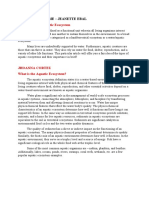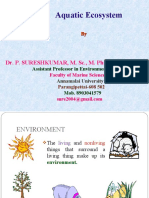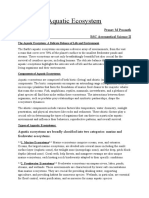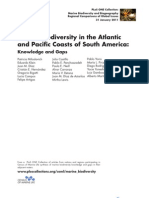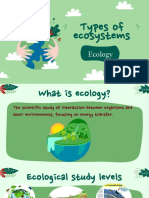Aquatic Ecosystem
Aquatic Ecosystem
Uploaded by
Mansi ManeCopyright:
Available Formats
Aquatic Ecosystem
Aquatic Ecosystem
Uploaded by
Mansi ManeOriginal Title
Copyright
Available Formats
Share this document
Did you find this document useful?
Is this content inappropriate?
Copyright:
Available Formats
Aquatic Ecosystem
Aquatic Ecosystem
Uploaded by
Mansi ManeCopyright:
Available Formats
AQUATIC ECOSYSTEM
An aquatic ecosystem is an ecosystem located in a body of
water. Communities of organisms that are dependent on each other and on their environment live
in aquatic ecosystems. The two main types of aquatic ecosystems are marine ecosystems
and freshwater ecosystems.
Types
Marine
Marine ecosystems cover approximately 71% of the Earth's surface and contain approximately
97% of the planet's water. They generate 32% of the world's net primary production.[1]They are
distinguished from freshwater ecosystems by the presence of dissolved compounds,
especially salts, in the water. Approximately 85% of the dissolved materials in seawater
are sodium and chlorine. Seawater has an average salinity of 35 parts per thousand (ppt) of
water. Actual salinity varies among different marine ecosystems.
Marine ecosystems can be divided into the following zones: oceanic (the relatively shallow part
of the ocean that lies over the continental shelf); profundal (bottom or deep
water); benthic(bottom substrates); intertidal (the area between high and low
tides); estuaries; salt marshes; coral reefs; and hydrothermal
vents (where chemosynthetic sulfur bacteria form the food base).
Classes of organisms found in marine ecosystems include brown
algae, dinoflagellates, corals, cephalopods, echinoderms, and sharks. Fish caught in marine
ecosystems are the biggest source of commercial foods obtained from wild populations.
Environmental problems concerning marine ecosystems include unsustainable exploitation of
marine resources (for example overfishing of certain species), marine pollution, climate change,
and building on coastal areas.
Freshwater
Freshwater ecosystems cover 0.80% of the Earth's surface and inhabit 0.009% of its total water.
They generate nearly 3% of its net primary production.[1] Freshwater ecosystems contain 41% of
the world's known fish species.
Magendira mani., Asst. Prof., IC., VNB Page 1
There are three basic types of freshwater ecosystems:
Lentic: slow-moving water, including pools, ponds, and lakes.
Lotic: rapidly-moving water, for example streams and rivers.
Wetlands: areas where the soil is saturated or inundated for at least part of the time.
Lake ecosystems can be divided into zones: pelagic (open offshore waters); profundal; littoral
(nearshore shallow waters); and riparian (the area of land bordering a body of water). Two
important subclasses of lakes are ponds, which typically are small lakes that intergrade with
wetlands, and water reservoirs. Many lakes, or bays within them, gradually become enriched by
nutrients and fill in with organic sediments, a process called eutrophication. Eutrophication is
accelerated by human activity within the water catchment area of the lake.
The major zones in river ecosystems are determined by the river bed's gradient or by the velocity
of the current. Faster moving turbulent water typically contains greater concentrations of
dissolved oxygen, which supports greater biodiversity than the slow moving water of pools.
These distinctions forms the basis for the division of rivers into upland and lowland rivers. The
food base of streams within riparian forests is mostly derived from the trees, but wider streams
and those that lack a canopy derive the majority of their food base from algae.Anadromous
fish are also an important source of nutrients. Environmental threats to rivers include loss of
water, dams, chemical pollution and introduced species.
Wetlands are dominated by vascular plants that have adapted to saturated soil. Wetlands are the
most productive natural ecosystems because of the proximity of water and soil. Due to their
productivity, wetlands are often converted into dry land with dykes and drains and used for
agricultural purposes. Their closeness to lakes and rivers means that they are often developed for
human settlement.
Ponds
These are a specific type of freshwater ecosystems that are largely based on
the autotroph algae which provide the base trophic level for all life in the area. The largest
predator in a pond ecosystem will normally be a fish and in-between range smaller insects and
microorganisms. It may have a scale of organisms from small bacteria to big creatures like water
snakes, beetles, water bugs, frogs, tadpoles, and turtles. This is important for the environment.
Magendira mani., Asst. Prof., IC., VNB Page 2
Functions
Aquatic ecosystems perform many important environmental functions. For example, they recycle
nutrients, purify water, attenuate floods, recharge ground water and provide habitats for wildlife.
Aquatic ecosystems are also used for human recreation, and are very important to
the tourism industry, especially in coastal regions.
The health of an aquatic ecosystem is degraded when the ecosystem's ability to absorb a stress
has been exceeded. A stress on an aquatic ecosystem can be a result of physical, chemical or
biological alterations of the environment. Physical alterations include changes in water
temperature, water flow and light availability. Chemical alterations include changes in the
loading rates of biostimulatory nutrients, oxygen consuming materials, and toxins. Biological
alterations include the introduction of exotic species. Human populations can impose excessive
stresses on aquatic ecosystems.
Abiotic characteristics
An ecosystem is composed of biotic communities and abiotic environmental factors, which form
a self-regulating and self-sustaining unit. Abiotic environmental factors of aquatic ecosystems
include temperature, salinity, and flow.
The amount of dissolved oxygen in a water body is frequently the key substance in determining
the extent and kinds of organic life in the water body. Fish need dissolved oxygen to survive.
Conversely, oxygen is fatal to many kinds of anaerobic bacteria.
The salinity of the water body is also a determining factor in the kinds of species found in the
water body. Organisms in marine ecosystems tolerate salinity, while many freshwater organisms
are intolerant of salt. Freshwater used for irrigation purposes often absorb levels of salt that are
harmful to freshwater organisms. Though some salt can be good for organisms.
Biotic characteristics
The organisms (also called biota) found in aquatic ecosystems are either autotrophic or
heterotrophic
Magendira mani., Asst. Prof., IC., VNB Page 3
Autotrophic organisms
Autotrophic organisms are producers that generate organic compounds from inorganic material.
Algae use solar energy to generate biomass from carbon dioxide and are the most important
autotrophic organisms in aquatic environments.[6] Chemosynthetic bacteria are found in benthic
marine ecosystems. These organisms are able to feed on hydrogen sulfide in water that comes
from volcanic vents. Great concentrations of animals that feed on this bacteria are found around
volcanic vents. For example, there are giant tube worms (Riftia pachyptila) 1.5m in length and
clams (Calyptogena magnifica) 30cm long.
Heterotrophic organisms
Heterotrophic organisms consume autotrophic organisms and use the organic compounds in their
bodies as energy sources and as raw materials to create their own biomass. Euryhaline organisms
are salt tolerant and can survive in marine ecosystems, while stenohaline or salt intolerant
species can only live in freshwater environments.
Magendira mani., Asst. Prof., IC., VNB Page 4
You might also like
- Ger Ms2021-01 Tsunami Hazard Maps Puget Sound Map Sheet 4 Georeferenced East Passage InundationDocument1 pageGer Ms2021-01 Tsunami Hazard Maps Puget Sound Map Sheet 4 Georeferenced East Passage InundationKING 5 NewsNo ratings yet
- Shore Protection M 02 Co AsDocument556 pagesShore Protection M 02 Co Asmishazujev100% (1)
- Pee (Module 4) - Aquatic EcosystemDocument28 pagesPee (Module 4) - Aquatic EcosystemToni Rose Hernandez LualhatiNo ratings yet
- Rijo Joy S4 Eee Roll No-42Document29 pagesRijo Joy S4 Eee Roll No-42Jobin VargheseNo ratings yet
- Aquatic EcosystemDocument7 pagesAquatic EcosystemWira SentanuNo ratings yet
- Aquatic Ecosystem - WikipediaDocument10 pagesAquatic Ecosystem - WikipediaLinn Maung HtetNo ratings yet
- Aquatic EcosystemDocument17 pagesAquatic Ecosystemyashrajeshinde1214No ratings yet
- Aquatic EcosystemDocument4 pagesAquatic EcosystemAngelyn De ArceNo ratings yet
- Aquatic BiomeDocument2 pagesAquatic BiomekikaykiNo ratings yet
- Prepared By: Mr. Edward M. Marzan Jr. Biological Science TeacherDocument28 pagesPrepared By: Mr. Edward M. Marzan Jr. Biological Science TeacherAngela Gayle BautistaNo ratings yet
- Pond Ecosystem: Piranha Pumps & Dredges Ponds Gold Radiance Hudson Float ValveDocument4 pagesPond Ecosystem: Piranha Pumps & Dredges Ponds Gold Radiance Hudson Float ValveSushmita Basu100% (1)
- Aquatic Eco SystemDocument37 pagesAquatic Eco Systemhitman agent 47No ratings yet
- Aquaticecosystemsppt 121008162921 Phpapp01Document18 pagesAquaticecosystemsppt 121008162921 Phpapp01Girlie Faith Morales BrozasNo ratings yet
- Freshwater EcosystemDocument22 pagesFreshwater EcosystemRitvik RitvikNo ratings yet
- Aquatic EcosystemDocument10 pagesAquatic EcosystemNooril MoujudhuNo ratings yet
- Introduction of Aquatic EcosystemDocument4 pagesIntroduction of Aquatic EcosystemjjgjocsonNo ratings yet
- Activity 5Document24 pagesActivity 5juliuspadua1985No ratings yet
- My LimnologyDocument49 pagesMy LimnologyLaiba HassanNo ratings yet
- Detritus Apex Predator SpecimenDocument6 pagesDetritus Apex Predator SpecimenTJ HarrisNo ratings yet
- Aquatic Biomes NotesDocument29 pagesAquatic Biomes NotesShekhar DhaliaNo ratings yet
- Flora and Fauna of Marine Ecosystem: Presented byDocument11 pagesFlora and Fauna of Marine Ecosystem: Presented bySANJAI POCONo ratings yet
- Marine Ecosystems Are Among The Largest of Earth'sDocument5 pagesMarine Ecosystems Are Among The Largest of Earth'skevinaveriaNo ratings yet
- Introduction of Aquatic EcosystemDocument4 pagesIntroduction of Aquatic EcosystemjjgjocsonNo ratings yet
- What Is EcologyDocument6 pagesWhat Is EcologyVel MuruganNo ratings yet
- Lecture 03 (Ecosystem)Document15 pagesLecture 03 (Ecosystem)osmanmahdy19No ratings yet
- TUGAS 08 Pengetahuan Fisik Laut'Document6 pagesTUGAS 08 Pengetahuan Fisik Laut'Rizaldi CaesarNo ratings yet
- Freshwater Ecosystem Final OutlineDocument13 pagesFreshwater Ecosystem Final OutlineSereneNo ratings yet
- Lecture For Fisheries 2014 Harmonised For StudentDocument134 pagesLecture For Fisheries 2014 Harmonised For StudentnataniumcscbeNo ratings yet
- Ecosystem 190103162038Document163 pagesEcosystem 190103162038sure2004No ratings yet
- Aquatic Science and Wetland Management 3rd Year Biology Dep'tDocument195 pagesAquatic Science and Wetland Management 3rd Year Biology Dep'telsa100% (2)
- Module 1 - Class 3Document12 pagesModule 1 - Class 3josephsebastian6812No ratings yet
- Aquatic EcosystemDocument3 pagesAquatic EcosystemPranavNo ratings yet
- Aquatic EcosystemDocument15 pagesAquatic EcosystemRIYA AhujaNo ratings yet
- Marine EcosystemDocument21 pagesMarine EcosystemPIYAM DAVENo ratings yet
- Rep in aquaDocument6 pagesRep in aquasanchezmafe42No ratings yet
- Biology ss2 First TermDocument42 pagesBiology ss2 First TermFrancis Adebayo Adeapin (ACTUALIZER)No ratings yet
- LABACTIVITYcasestudyDocument5 pagesLABACTIVITYcasestudyDanzel LutaoNo ratings yet
- Environmental Microbiology NoteDocument8 pagesEnvironmental Microbiology Notemarvelouschidinma5No ratings yet
- PEE - Lesson 1 (MT)Document13 pagesPEE - Lesson 1 (MT)khlneNo ratings yet
- 476 MCB 409 Environmental MicrobiologyDocument26 pages476 MCB 409 Environmental MicrobiologyAbdulkadir HassanNo ratings yet
- Gojo, Rhianna E. - Group 4.Document3 pagesGojo, Rhianna E. - Group 4.lalalalalisam8No ratings yet
- Introduction of Aquatic EcosystemDocument5 pagesIntroduction of Aquatic EcosystemjjgjocsonNo ratings yet
- Online AssignmentDocument10 pagesOnline Assignmentjisha26No ratings yet
- Aquatic EcosystemsDocument2 pagesAquatic EcosystemsJonas ColipanoNo ratings yet
- Aquatic Ecosystems-Marine Types: October 2011Document10 pagesAquatic Ecosystems-Marine Types: October 2011NierNo ratings yet
- Marine Zones - ReportDocument4 pagesMarine Zones - ReportTJ HarrisNo ratings yet
- Natsci 13Document9 pagesNatsci 13Yuji KojimaNo ratings yet
- PEE - Lesson 2 (MT)Document22 pagesPEE - Lesson 2 (MT)khlneNo ratings yet
- Aquatic EcosystemsDocument14 pagesAquatic EcosystemsCris Ann Chatto IINo ratings yet
- Marine BiologyDocument4 pagesMarine Biologys13188No ratings yet
- INTRODUCTION of pondDocument5 pagesINTRODUCTION of pondRavleen KourNo ratings yet
- Clyteshane E. Soberano Beed 4ADocument1 pageClyteshane E. Soberano Beed 4AClyte SoberanoNo ratings yet
- 13module in Environmental ScienceDocument4 pages13module in Environmental Scienceelise tanNo ratings yet
- Aquatic MicrobiologyDocument13 pagesAquatic MicrobiologyOgwoGP33% (3)
- Marine Life, or Sea Life or Ocean Life, Is TheDocument1 pageMarine Life, or Sea Life or Ocean Life, Is TheMarie MirallesNo ratings yet
- Aquatic Ecosystem and TypesDocument2 pagesAquatic Ecosystem and TypesGlorylourd Joana FulloNo ratings yet
- Prepared By: Odessa F. Dysangco Teacher IDocument42 pagesPrepared By: Odessa F. Dysangco Teacher IRenzo TorresNo ratings yet
- Kami Export - Ishan Gole - HumanEffectonResourcesDocument6 pagesKami Export - Ishan Gole - HumanEffectonResourcesIshan GoleNo ratings yet
- Aquatic EcosystemDocument31 pagesAquatic Ecosystemlalalalalisam8No ratings yet
- Study of Simple Types of EcosystemDocument32 pagesStudy of Simple Types of EcosystemsatishbukkiNo ratings yet
- The Aquatic BiomeDocument4 pagesThe Aquatic BiomeKashiNo ratings yet
- Biomes of The World: Environmental, Ecology Bio-Diversity & Climate ChangeDocument21 pagesBiomes of The World: Environmental, Ecology Bio-Diversity & Climate ChangeMeenakshi SahuNo ratings yet
- Ecosystem Facts That You Should Know - The Fresh and Saltwater Edition - Nature Picture Books | Children's Nature BooksFrom EverandEcosystem Facts That You Should Know - The Fresh and Saltwater Edition - Nature Picture Books | Children's Nature BooksNo ratings yet
- ECW571Document5 pagesECW571Ally ChorNo ratings yet
- Kerala Fact SheetDocument6 pagesKerala Fact SheetAnonymous 3akQhQFJSLNo ratings yet
- Lab 6 - Currents and Waves 2021Document6 pagesLab 6 - Currents and Waves 2021juanNo ratings yet
- Tsunami DescriptionDocument15 pagesTsunami DescriptionSundarPrabhaNo ratings yet
- Catalogue NHODocument32 pagesCatalogue NHOArup NathNo ratings yet
- Annual Edition 2016Document63 pagesAnnual Edition 2016Raju Gopinathan NairNo ratings yet
- Catch The Fundy Action: AttractionsDocument10 pagesCatch The Fundy Action: AttractionsgeoformNo ratings yet
- Comprehension Tsunami Pages Deleted Pages DeletedDocument12 pagesComprehension Tsunami Pages Deleted Pages Deletedapi-527988688No ratings yet
- (Ebook PDF) Descriptive Physical Oceanography: An Introduction 6th Edition Download PDFDocument49 pages(Ebook PDF) Descriptive Physical Oceanography: An Introduction 6th Edition Download PDFeldobroyer100% (3)
- WCS - Lecture 5 and 6Document90 pagesWCS - Lecture 5 and 6Md. Muhaiminul IslamNo ratings yet
- Limitation of Tidal EnergyDocument9 pagesLimitation of Tidal EnergyMayank KiranNo ratings yet
- T e 1629879644 Lks2 Tsunami Differentiated Reading Comprehension Activity Ver 1Document16 pagesT e 1629879644 Lks2 Tsunami Differentiated Reading Comprehension Activity Ver 1Fatma RamadanNo ratings yet
- C9 Destruction of Coral Reefs PorrasDocument20 pagesC9 Destruction of Coral Reefs PorrasBrilliant Jay LagriaNo ratings yet
- MILOSLAVICH Et Al 2011Document44 pagesMILOSLAVICH Et Al 2011Ma Valeria RetanaNo ratings yet
- Strategic Significance of Arabian SeaDocument4 pagesStrategic Significance of Arabian SeaShamshad Ali RahoojoNo ratings yet
- Aq. R & E - Set ADocument7 pagesAq. R & E - Set ALaiza UsopNo ratings yet
- LE Science 5 MELC 9Document6 pagesLE Science 5 MELC 9Pauline Erika Cagampang100% (1)
- Drijfhout 2013Document26 pagesDrijfhout 2013anhLeNo ratings yet
- Coastal Features - LandformsDocument13 pagesCoastal Features - Landforms3alliumcourt100% (3)
- Final Year Project Report-2Document43 pagesFinal Year Project Report-2zon9868No ratings yet
- Weathering and Erosion NotesDocument7 pagesWeathering and Erosion NotesSudharshini SridharanNo ratings yet
- Types of EcosystemsDocument20 pagesTypes of Ecosystemssofia londoñoNo ratings yet
- Assignment 5 Geo 334Document13 pagesAssignment 5 Geo 334imaadNo ratings yet
- Tsunami Warning SystemDocument27 pagesTsunami Warning Systemd_melanaNo ratings yet
- Grade 10 Science Q1 Ep4 - TsunamiDocument15 pagesGrade 10 Science Q1 Ep4 - TsunamiIvy Gyn Llamera ElsisuraNo ratings yet
- Geography T2Y10Document15 pagesGeography T2Y10BEYZA POYRAZNo ratings yet
- wk1 - Blue PlanetDocument41 pageswk1 - Blue PlanetAnaNo ratings yet















